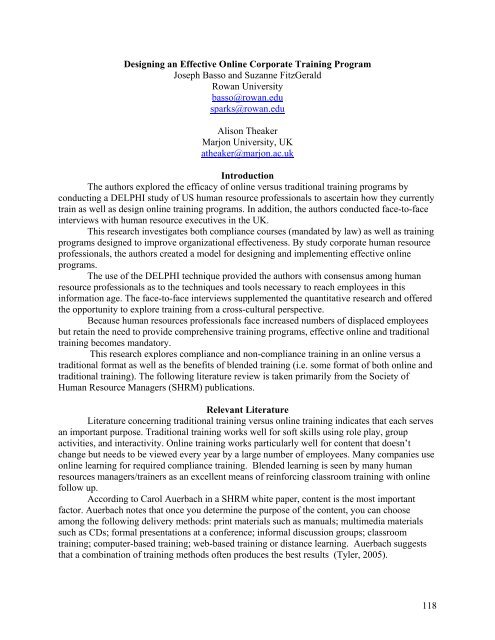2008 PROCEEDINGS - Public Relations Society of America
2008 PROCEEDINGS - Public Relations Society of America
2008 PROCEEDINGS - Public Relations Society of America
You also want an ePaper? Increase the reach of your titles
YUMPU automatically turns print PDFs into web optimized ePapers that Google loves.
Designing an Effective Online Corporate Training Program<br />
Joseph Basso and Suzanne FitzGerald<br />
Rowan University<br />
basso@rowan.edu<br />
sparks@rowan.edu<br />
Alison Theaker<br />
Marjon University, UK<br />
atheaker@marjon.ac.uk<br />
Introduction<br />
The authors explored the efficacy <strong>of</strong> online versus traditional training programs by<br />
conducting a DELPHI study <strong>of</strong> US human resource pr<strong>of</strong>essionals to ascertain how they currently<br />
train as well as design online training programs. In addition, the authors conducted face-to-face<br />
interviews with human resource executives in the UK.<br />
This research investigates both compliance courses (mandated by law) as well as training<br />
programs designed to improve organizational effectiveness. By study corporate human resource<br />
pr<strong>of</strong>essionals, the authors created a model for designing and implementing effective online<br />
programs.<br />
The use <strong>of</strong> the DELPHI technique provided the authors with consensus among human<br />
resource pr<strong>of</strong>essionals as to the techniques and tools necessary to reach employees in this<br />
information age. The face-to-face interviews supplemented the quantitative research and <strong>of</strong>fered<br />
the opportunity to explore training from a cross-cultural perspective.<br />
Because human resources pr<strong>of</strong>essionals face increased numbers <strong>of</strong> displaced employees<br />
but retain the need to provide comprehensive training programs, effective online and traditional<br />
training becomes mandatory.<br />
This research explores compliance and non-compliance training in an online versus a<br />
traditional format as well as the benefits <strong>of</strong> blended training (i.e. some format <strong>of</strong> both online and<br />
traditional training). The following literature review is taken primarily from the <strong>Society</strong> <strong>of</strong><br />
Human Resource Managers (SHRM) publications.<br />
Relevant Literature<br />
Literature concerning traditional training versus online training indicates that each serves<br />
an important purpose. Traditional training works well for s<strong>of</strong>t skills using role play, group<br />
activities, and interactivity. Online training works particularly well for content that doesn’t<br />
change but needs to be viewed every year by a large number <strong>of</strong> employees. Many companies use<br />
online learning for required compliance training. Blended learning is seen by many human<br />
resources managers/trainers as an excellent means <strong>of</strong> reinforcing classroom training with online<br />
follow up.<br />
According to Carol Auerbach in a SHRM white paper, content is the most important<br />
factor. Auerbach notes that once you determine the purpose <strong>of</strong> the content, you can choose<br />
among the following delivery methods: print materials such as manuals; multimedia materials<br />
such as CDs; formal presentations at a conference; informal discussion groups; classroom<br />
training; computer-based training; web-based training or distance learning. Auerbach suggests<br />
that a combination <strong>of</strong> training methods <strong>of</strong>ten produces the best results (Tyler, 2005).<br />
118
















